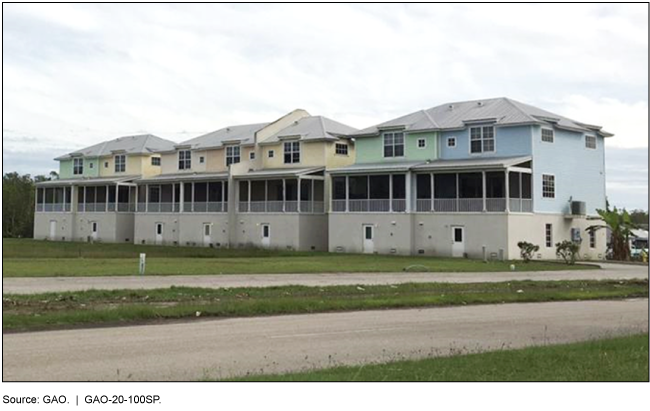Disaster Resilience Framework: Principles for Analyzing Federal Efforts to Facilitate and Promote Resilience to Natural Disasters
Fast Facts
Since 1980, weather disasters in the U.S. have caused more than $1.6 trillion in damage. Weather disasters, and federal spending on them, are expected to increase due to climate change, as our High Risk List indicates.
Federal efforts to promote disaster resilience can help limit damage—and cost. This framework lays out 3 broad principles to guide these efforts:
Information—Ensuring decision makers can accurately assess risks, decide what to do, and measure outcomes
Integration—Coordinating federal efforts and recognizing connections for a “whole system” perspective
Incentives—Providing financial and other incentives and reducing disincentives
Elevated homes with tin roofs in Florida to protect them from wind damage

A row of homes with tin roofs
Highlights
What GAO Found
GAO created the Disaster Resilience Framework to serve as a guide for analysis of federal actions to facilitate and promote resilience to natural disasters. It is organized around three broad overlapping principles and a series of questions that those who provide oversight or management of federal efforts can consider when analyzing opportunities to enhance their contribution to national disaster resilience. The principles are (1) information, which is about giving federal and nonfederal decision makers authoritative and understandable information to help identify current and future risks, as well as the impact of risk-reduction strategies; (2) integration, which is about enabling decision makers to take coherent and coordinated actions; and incentives, which is about making long-term, forward-looking, risk-reduction investments more viable and attractive among competing priorities.
Why GAO Did This Study
GAO has identified the rising number of natural disasters and increasing reliance on federal assistance as a significant source of federal fiscal exposure In the last 3 years alone, there have been about $183 billion in select supplemental appropriations for disaster assistance to multiple federal agencies and annual appropriations to the Disaster Relief Fund. Since 1980, the U.S. has experienced 254 climate and weather disasters causing more than $1 billion in damage each and totaling over $1.7 trillion. The U.S. Global Change Research Program (USGCRP) projects increases in the severity and frequency of certain extreme weather and climate-related events, which will have negative economic impacts.
Disaster resilience helps to reduce the impact of climate-related events on people and property. Recognizing the gravity of the effect of these disasters on the American people and the fiscal exposure it creates, GAO created the framework to help those who have responsibility for oversight and management of federal efforts to consider what they might do that will result in federal and nonfederal decision makers taking action to increase disaster resilience throughout the nation.
For more information, contact Chris Currie at (404) 679-1875 or curriec@gao.gov.
